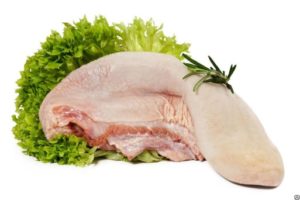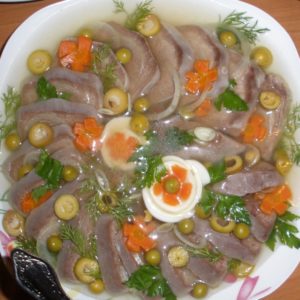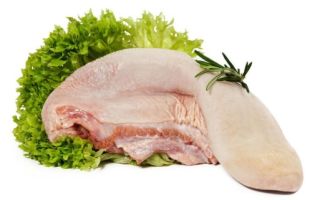Content
- 1 Composition and calorie content of pork tongue
- 2 Useful properties of pork tongue
- 3 Is it possible to eat pork tongue for pregnant and lactating women
- 4 Can a child be given pork tongue
- 5 Is pork tongue good for diabetes
- 6 Pork tongue for pancreatitis and stomach ulcers
- 7 How to clean a pork tongue
- 8 How and how much to cook pork tongue until tender
- 9 Pork tongue recipes
- 10 Pork tongue harm and contraindications
- 11 How to choose and store pork tongue
- 12 Conclusion

No matter how nutritionists around the world protest, trying to prove that pork does more harm than good, in spite of all it remains the most common meat today. The tongue occupies a special niche among pork delicacies. This part of the pig carcass belongs to category I offal, and is not inferior in taste and nutritional value to premium meat. People love dishes with this healthy component for their delicate, mild taste and satiety. However, it will be useful to every gourmet to figure out what the benefits and harms of the pork tongue are.
Composition and calorie content of pork tongue
The calorie content of a pork tongue per 100 g is 303 Kcal, which is approximately 22% of the daily requirement. A Hundred Gram Serving Also Contains:
- 27 g protein;
- 22 g fat;
- 55 g of water.
Vitamins:
- B1 - 0.2 mg;
- B2 - 0.4 mg;
- B6 - 0.6 mg;
- B9 - 5.5 mcg;
- B12 - 1.5 mcg;
- E-1.7 mg;
- PP - 9.4 mg;
- Niacin - 5.1 mg
-Macro and -microelements:
- potassium, K - 109 mg;
- calcium, Ca - 15 mg;
- magnesium, Mg - 29 mg;
- sodium, Na - 74 mg;
- sulfur, S - 262 mg;
- phosphorus, Ph - 212 mg;
- iron, Fe - 4.3 mg;
- cobalt, Co - 5.5 μg;
- manganese, Mn - 0.03 mg.
Sterols:
- cholesterol - 92.5 mg;
- saturated fatty acids - 9.4 g
Useful properties of pork tongue
Useful properties include a composition rich in vitamins and minerals. If you eat pork tongue dishes 2 - 3 times a week, the state of immunity and resistance to various viruses and infections will significantly improve. This can significantly reduce the risk of getting such a pathology as anemia, since B vitamins are involved in the process of hematopoiesis. Cobalamin (B12) has the beneficial properties of improving the condition of the skin and mucous membranes. Vitamin B12 also plays a key role in the metabolism and formation of amino acids. Animal protein has the beneficial property of suppressing hunger for a long time, as it contains a large amount of protein and is quickly absorbed by the stomach. With a diet, this property of the pork tongue is simply irreplaceable.
Is it possible to eat pork tongue for pregnant and lactating women
The opinions of nutritionists about the introduction of pork tongue into the diet during pregnancy and during breastfeeding differ. On the one hand, it is beneficial, since it has a high content of useful macro- and microelements, which has a beneficial effect on the condition of the bone, muscle and other systems of a pregnant woman. In addition, a woman, while carrying a child, experiences a double load, which often leads to anemia. The benefit of this type of by-product is the property to reduce the risk of developing this pathology, since the vitamins contained in it are involved in hematopoiesis. Pork tongue is also useful for a nursing mother, since its high nutritional value contributes to the production of milk and the improvement of its quality.On the other hand, it is capable of provoking an allergic reaction, which can harm the health of both the mother and the child.
Can a child be given pork tongue
It is recommended for children to introduce offal into complementary foods, including pork tongue, from the age of 3. Puree from it turns out to be tender, contains little connective tissue and a large amount of protein, is easily absorbed by the children's stomach and has a high nutritional value. However, before introducing a new type of meat into a child's diet, it is necessary to consult a pediatrician.
Is pork tongue good for diabetes
People suffering from a disease such as diabetes mellitus should give preference to the latter when choosing between pork and beef tongues. This is due to the low cholesterol content compared to pork, which is harmful to the diabetic patient. However, both types of offal contain almost the same amount of vitamin B12 and B6, which are beneficial for diabetics. Lack of these vitamins significantly impairs insulin receptor sensitivity.
Pork tongue for pancreatitis and stomach ulcers
People with diseases of the gastrointestinal tract, such as:
- gastritis,
- pancreatitis;
- ulcer,
It is contraindicated to consume this type of meat due to its high cholesterol content.
This can be harmful to health and provoke a number of negative consequences:
- the formation of plaques in the vessels;
- increased risk of stroke and heart attack.
How to clean a pork tongue

Initially, it is necessary to soak it in warm water for 2-2.5 hours, then thoroughly clean it with a metal brush or a hard sponge and rinse with water. Since it is easier to remove the skin from a boiled tongue, you need to immerse it in boiling water for 5 minutes, then sharply place it in a container with cold water. The sharp temperature drop makes it easier to separate the skin from the meat.
After the skin is removed, it is necessary to cook it until tender.
Description with a visual demonstration of cleaning a pork tongue in the video:
How and how much to cook pork tongue until tender

The weight of an organ is from 250 to 400 g. There are no coarse fibers in its meat, due to which the product is perfectly digested and absorbed by the body.
However, in order for the finished pork tongue to be soft, juicy and tender, it must be cooked for 1.5 to 3 hours. Such a large time variation is explained by the fact that the age of the pig directly affects the duration of this process. The younger the pig, the less time it takes to boil the tongue, and, conversely, it will take more time to boil the tongue of a mature pig.
Pork tongue recipes
A properly processed and boiled tongue is already a complete and tasty dish in itself. However, there are many recipes using this meat. Due to the absence of intercellular fluid and connective tissue in it, consisting of collagen fibers, which have the property of thickening during boiling, the delicacy retains its soft and delicate consistency after cooking.
Pork tongue salad

This hearty salad is distinguished by a successful combination of ingredients that complement each other and against which the taste of pork tongue opens up in a completely new way.
Ingredients:
- pork tongue - 1 pc .;
- chicken eggs - 4 pcs.;
- pickled - cucumbers-3 pcs.;
- champignons - 150 g;
- hard cheese - 150 g;
- Greek yogurt for dressing to taste.
Preparation:
- Peel the product, boil and cool.
- Cut the tongue, cucumbers and eggs.
- Cut fresh mushrooms and fry until golden brown in vegetable oil.
- Place all components in a container, season with yogurt or mayonnaise and mix.
- Grate the cheese on a coarse grater, add to the salad and mix again.
- You can decorate the food with herbs if you wish.
Pork tongue jellied

You do not need to be the owner of outstanding culinary talents to prepare your favorite healthy and tasty snack.Aspic is being prepared in a matter of minutes and will be an excellent option for treating the festive table.
Ingredients:
- pork tongue - 1 pc .;
- carrots - 1 pc.;
- celery - 1 root;
- water - 400 ml;
- salt to taste;
- black pepper - 3 - 4 peas;
- a bunch of greens;
- gelatin.
Preparation:
- Boil the components.
- Cool and cut into slices.
- Strain the broth and bring to a boil.
- Prepare gelatin broth (soak a bag of gelatin in water and leave for 10 - 15 minutes) and add it to the main broth.
- Place the chopped ingredients evenly in a deep bowl and pour over the slightly cooled broth.
- Sprinkle with herbs and pepper on top, place in the refrigerator for 3 - 4 hours.
Pork tongue harm and contraindications
In addition to benefits, boiled pork tongue can be harmful. It's all about the large amount of cholesterol in its composition. In this regard, it is not recommended to use it for people suffering from diseases such as:
- gastrointestinal problems (pancreatitis, gastritis, stomach ulcer);
- atherosclerosis;
- liver disease;
- allergy.
How to choose and store pork tongue
When choosing, you need to pay attention to the skin. A sign of freshness will be a pale pink or red color. To the touch - of moderate density without seals, knots and darkening. The refrigerated product can be stored between 0 and -15 aboutWith no more than 24 hours, boiled - in a tightly closed container for no more than 72 hours. Once frozen, the product will retain its benefits in the freezer for no more than a month. However, before freezing, it must be thoroughly cleaned, cut into small pieces and placed in a special freezer bag. To preserve all the useful properties, it is better to defrost it on the bottom shelf of the refrigerator.
Conclusion
The answer to the question of what are the benefits and harms of pork tongue depends on the conditions for the correct preparation and use of this product. If all recommendations are followed and contraindications are taken into account, the benefits of the delicacy for the human body are obvious. Today, using the Internet, you can find a large number of delicious and healthy recipes for its preparation: experiment - and each time a healthy and nutritious delicacy will reveal its new flavor facets!

